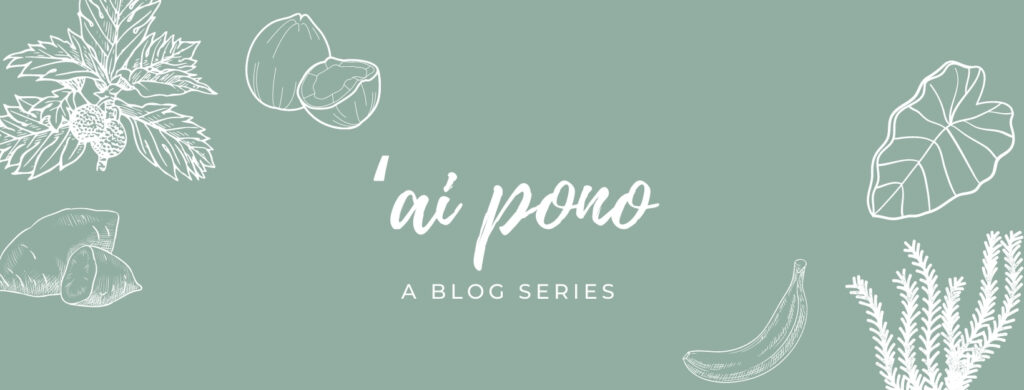Holo iʻa ka papa, kau ʻia e ka manu. Where there is food, people gather.
Food is central in every culture, fostering traditions and a sense of community, while also providing us with the nutrients we need to live. In ‘Ai Pono, we will explore the interconnectedness of Native Hawaiian food systems and access, nutrition, and sustainability. Through this series, we will attempt to draw connections between traditional Native Hawaiian food and health/well-being.
When we think about nutrition, we may not necessarily consider how our present health may have been impacted by our health as young as when we were infants.
During infancy, nutrition is especially important, as it is a period that can be linked with health during later stages of life. Studies have shown that early feeding practices can play a significant role in preventing diseases and promoting health.¹

Marie Kainoa Fialkowski Revilla, an associate professor in the Department of Human Nutrition, Food, and Animal Sciences at the University of Hawai‘i at Mānoa, spoke about the importance of good nutrition during infancy.
“The likelihood for being overweight, when (babies are) older, can be influenced by, their diet during infancy. … There’s just lots of evidence that suggests that, through healthy complementary feeding, having a diverse diet, it’s going to improve their health outcomes, reduce their likelihood for chronic disease,” she said.
The World Health Organization (WHO) defines complementary foods as the solid foods that guardians introduce when infants reach a stage in which breast milk or formula can no longer provide them with all the nutrients they need. They are complementary because they are solid foods that guardians introduce along with breast milk or formula.²
As the foods that infants are eating to help them grow into healthy children, there are four important considerations that the WHO suggests guardians take into account when selecting and preparing complementary foods for their infants.
“We should … think about the best diet, the best foods. We want to be setting them up for success,” Dr. Fialkowski Revilla said.
The first consideration the WHO notes is timing – when to introduce complementary foods to infants. Typically, babies are ready for complementary foods when they are around 6 months old. Timing is important as it can impact the infant’s likelihood of becoming overweight or obese at later stages in life, as well as their growth and development. ²
The second is ensuring that the foods are providing adequate nutrition, energy, protein, and micronutrients.² Fialkowski Revilla said it’s important that complementary foods are high in iron and zinc, as breastmilk and formula do not provide enough at the 6-month stage.
“With complementary foods, you really want to focus on the vegetables – poi, starchy roots,” she said.
The third consideration is ensuring that the foods are safe – stored and preparedhygienically.²
The final consideration is ensuring infants are being fed enough and in the right frequency for their needs and age. The WHO recommends starting off with mashed foods or semi-solid when babies are between 6-8 months old, and that guardians feed babies from two to three times a day, increasing to feeding them three to four times a day when they are around 9 months old. By the time infants are around 1 year old, the WHO recommends introducing children to the foods the family is eating. ²
On top of the WHO’s considerations, Fialkowski Revilla notes that the diversity of complementary foods is especially important.
“You’re more likely to meet your nutrient needs if you’re eating a diverse group of foods,” Fialkowski Revilla said. “Encoura(ge) exploration. If you’re exploring, and you’re exploring with your keiki, they’re going to be more likely to be adventurous. That’s the other thing too, is that you want your kids to be adventurous eaters. And the only way they’re going to be adventurous is if you expose them to lots of different flavors. And so that they’re willing to try. We want them to be willing to try. And if they’re willing to try, then they’re more likely to like the food.”
Traditional Native Hawaiian foods hold a lot of nutritional benefits for babies, along with having cultural value.
“We have a lot of really great traditional foods here, and we want to make our babies ʻono for those foods,” Fialkowski Revilla said. “Those cultural foods are very meaningful. They carry a lot of value and spiritual benefit, and, with the idea too of the mana and food and things like that, it’s such a shared experience.”
Some examples of traditional Hawaiian complementary foods can include ʻuala (breadfruit), poi, mashed kukui nuts, sauces made with opihi, ʻaʻama (crab), and vegetables and herbs.³
“Our traditional foods, like when we think about lūʻau – the green leaves – I mean, that is packed (with) so many nutrients. It’s so good – vitamins, the fiber – and it just tastes ʻono,” she said.
In one of her studies, Fialkowski Revilla found that poi was an especially popular first food among moms. Poi is a good example of a complementary food because it’s versatile, its consistency can be modified based on the baby’s development, and it’s nutrient-dense with minerals, vitamins, and fiber, Fialkowski Revilla said. She also noted that some moms mixed poi with breast milk or formula, others with sweet potato or rice cereal.
As important as nutrition is for infants, Fialkowski Revilla noted how nutrition is very much a family effort.
“We say that we want babies to be eating diverse diets, I think it goes the same for families,” Fialkowski Revilla said. “If they see mommy eating it, they see daddy eating it, they see brother and sister eating it, they see grandma eating, if they see everybody eating it, then they’re going to be more likely to want to eat it. So, I would say it’s not something that’s in isolation. If everybody’s working together, it’s much easier to live that healthy lifestyle.”
In one of the studies Fialkowski Revilla did, she found that many mothers were seeking feeding advice within their own families – their moms, mothers-in-law, sisters, or aunties.
“We need to really think about our families, and the communities that our families live in, the policies that influenced the communities that our families live in. I think it’s not just a simple strategy to ensuring that our babies are eating well. Our families have to eat well, our mommies have to eat well, our communities have to have access to be able to eat well, everything is all connected,” she said. “The more we can involve everyone, so the whole family is involved in kind of preparing the meal and putting it together, everybody has kuleana.”
While it’s important for babies to eat diverse diets, Fialkowski Revilla notes that exploring food doesn’t have to be exclusive to babies.
“You want them to pick up and be exposed to lots of different textures. It’s kind of like they’re playing with their food, they’re exploring with your food, and so why can’t we also explore foods, explore different pairings, or explore different ways to make food? Just don’t be afraid. Sometimes it’ll come out great, and sometimes it may not come out that great, but it’s OK, right? Because we’re having fun with her food,” she said.
One way Fialkowski Revilla suggested experimenting with foods is by modernizing traditional Native Hawaiian foods.
“So, our traditional foods – instead of eating (just) poi, add it with some fruit, throw some granola on there. You can kind of modernize some of the foods, too, so that you can incorporate them into your diet in multiple different ways,” she said.
Currently, Fialkowski Revilla is doing a study that tracks through photos that moms upload to a mobile app what babies eat throughout their first year. She hopes her study will provide pertinent data and information that comes from the community and ensures that foods and support programs, health promotion events, and activities are being delivered in an appropriate and acceptable way that addresses the needs of the community.
“Ultimately, I want a thriving lāhui. I want a healthy lāhui. I want our babies to grow up to be healthy adults,” she said. “I think we could all learn from babies, right? If we can all eat diverse we’re going to do pretty good if we can drink water, we’re going to do pretty good.”
~ Na Maris Tasaka, Communications Assistant
—–
Marie Kainoa Fialkowski Revilla is an associate professor in the Department of Human Nutrition, Food and Animal Sciences at the University of Hawai‘i at Mānoa’s College of Tropical Agriculture and Human Resources. Her research focuses on nutrition and health in indigenous populations and infant nutrition. Fialkowski Revilla grew up in Waiāhole Valley and graduated from Maryknoll School. She got her undergraduate degree from Dartmouth College and received her master’s degree and PhD from Purdue University.
If you are interested in participating in Fialkowski Revilla’s current study, are 18 years old or older, Native Hawaiian, and an Oʻahu resident, you can contact 808-375-3785 for more information or email [email protected].
Further Readings/Media
- What Are Native Hawaiian Babies Eating? UH Researchers Want to Know
- Kūlana ʻAiaola: So ʻOno! with Dr. Marie Kainoa Fialkowski Revilla
- World Health Organization – Complementary Feeding
Citations
- Fialkowski, Marie K et al. “Type, Timing, and Diversity of Complementary Foods Among Native Hawaiian, Pacific Islander, and Filipino Infants.” Hawaiʻi Journal of Health & Social Welfare vol. 79,5 Suppl 1 (2020): 127-134.
- “Complementary Feeding.” World Health Organization, www.who.int/health-topics/complementary-feeding#tab=tab_1.
- Fialkowski, Marie K, et al. “Native Hawaiian Complementary Feeding Practices as Told by Grandparents: A Transgenerational Experience.” Current Developments in Nutrition, 26 May 2020, doi:10.1093/cdn/nzaa086.

